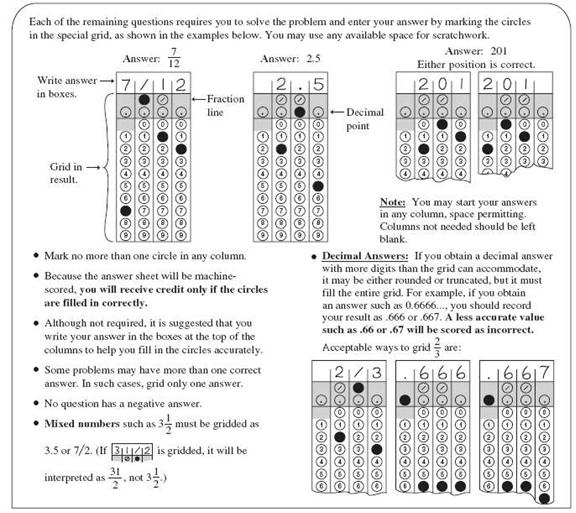The SAT Math section that is call “Student-Response Questions” involve gridded answer choices. That is, they have similar questions to the multiple-choice questions on the rest of the SAT Math section, but they require you to calculate the answer on your own and then enter it into an answer grid.
This is the third article in a series of articles about SAT Math Answer Choices. The series includes:
Multiple Choice Questions for SAT Math
Eliminating SAT Math Answer Choices
SAT Math Student-Produced Responses (Answer Grids)
SAT Math Student-Produced Responses (Answer Grids)
The instructions for gridded responses on the SAT Math section are like the following:

Read through these instructions now so that you won’t have to on test day. Reading instructions on test day can cost you a couple of points on each section.
The grids you complete will be read by a computer. The computer cannot read handwriting, so the important point is to fill out the ovals completely, just as with the rest of the answer grid. The space above the grid is for you to write the answer. You should do this even though the computer cannot read your writing because it will help you grid accurately.
You are allowed to formulate your answer as a decimal or a fraction for any question. Obviously, if the problem involves simplifying a fraction, there is no point in whipping out the calculator and converting into a decimal. Likewise, if you used your calculator to determine the answer, there is no need to convert to a fraction. Just accurately grid your response and move on.
Be careful gridding your fractions. You must convert mixed numbers into fractions or decimals or the computer will not make sense of your intended answer. For example, if the answer is 5 ½, you should enter either 11/2 or 5.5. If you try to enter 5 ½ the computer will read it as 51/2, which of course will cost you a point.
There are only four possible digits to an answer, and that includes fraction lines (/) and decimal points. So there is no point in working an answer past three decimal places – round the answer and grid it.
Note that there are no negative number answers – if you came up with a negative number as an answer you did the problem incorrectly.
It is possible that there can be more than one correct answer for a problem. In this case, just grid one of the answers. This is probably because the answer is a range of values. For example, the answer might range between 7 and 8. If so, write something in the middle, like 7.5. But do not right in a mixed answer or the computer will read it incorrectly (e.g., do not write 7 ½ or the computer will think you meant 71/2 which is actually 35.5 and well out of the range of the correct answer).
The only real downside to Student-Response Questions on the SAT Math section is that you cannot work backward and eliminate answer choices. There are no answer choices.
One possible upside is that the gridded answers are amenable to calculator work (amenable is a good word to know for the SAT Verbal section – it is a synonym for “open to,” or “agreeable”). So if you don’t like fractions, you could crunch them through your calculator. Take a look at the following as an example:
|
If
|
4 |
< x <
|
5 |
Find one value of x.
|
| 9 |
9 |
You could solve this without a calculator this way:
|
To get a value between
|
4 |
and
|
5 |
multiply both by 2
|
| 9 |
9 |
|
And you come up with
|
8 |
and
|
10 |
|
| 18 |
18 |
|
So we end up with
|
8 |
< x <
|
10 |
and x could be
|
9
|
| 18 |
18 |
18 |
Which could also be gridded as ½ or “.5” for your answer.
You could alternatively take the calculator approach:
|
Where
|
4 |
is also .44444… and
|
5 |
is 55555….
|
| 9 |
9 |
And if .4444444 < x < .5555555, then the right answer could be something like .48 or .5 or .53, etc.
This concludes our overview of SAT Math Multiple Choice Questions. Please return to our SAT page for more articles.

